How to Run Downhill (or Down Mountains!) and Up Hill
 Karen Parnell
September 01, 2024
Karen Parnell
September 01, 2024
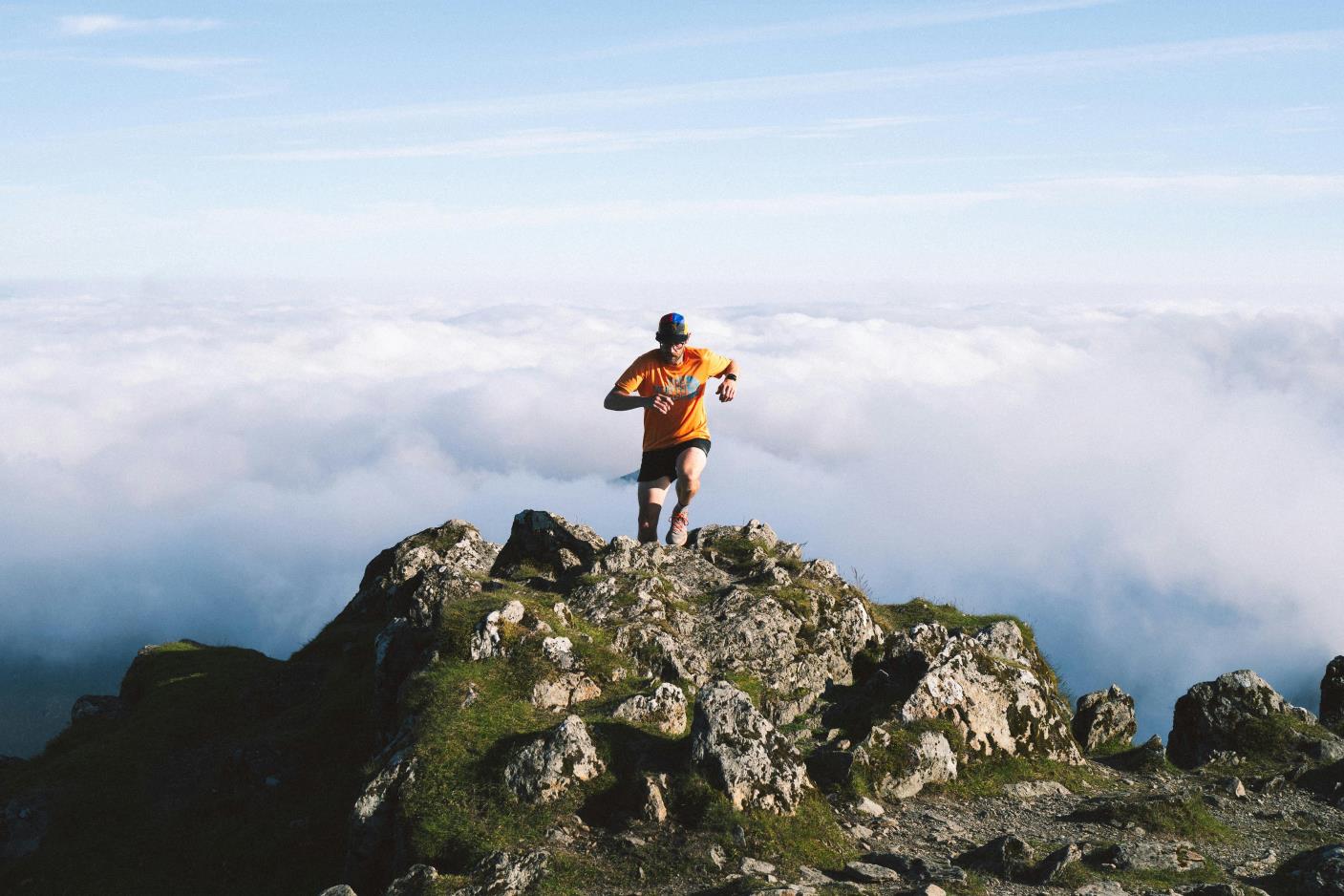
Photo by Jack Atkinson
How to Run Downhill (or Down Mountains!) and Up Hill
I live up a mountain (750 metres or 2460 feet) so when I go for a run there will always be some downhill and uphill running! Over the years my knees have become a bit sore which I have learned to live with more or less. I take the time to strengthen my legs, hips and core to ensure that my knee’s keep aligned and the knee cap stable during cycling and running, but I was still suffering from a dull pain behind my knee cap on the down hills. I have tried resting, ice and stretching well after each run but nothing seems to work. So, I have been researching techniques for downhill running. I like to experiment on myself and I think I’ve found what works for me (and may work for you if you suffer in the same way?).
I have no pain running uphill and even though its harder from a cardio perspective it feels good and is certainly a great way to get your fitness and speed back quicker than running on the flat. Most people focus on this part – “running tall,” with your head, shoulders, hips, and ankles aligned, looking ahead rather than down, using your arms more as you lift your knees, but keep your shoulders and arms relaxed, and the insides of your wrists passing near your waist. Always lean forward from the ankle and not the hip. But when we hit the top we tend to think of the downhill as free wheeling on our bikes and switch off when it comes to technique.
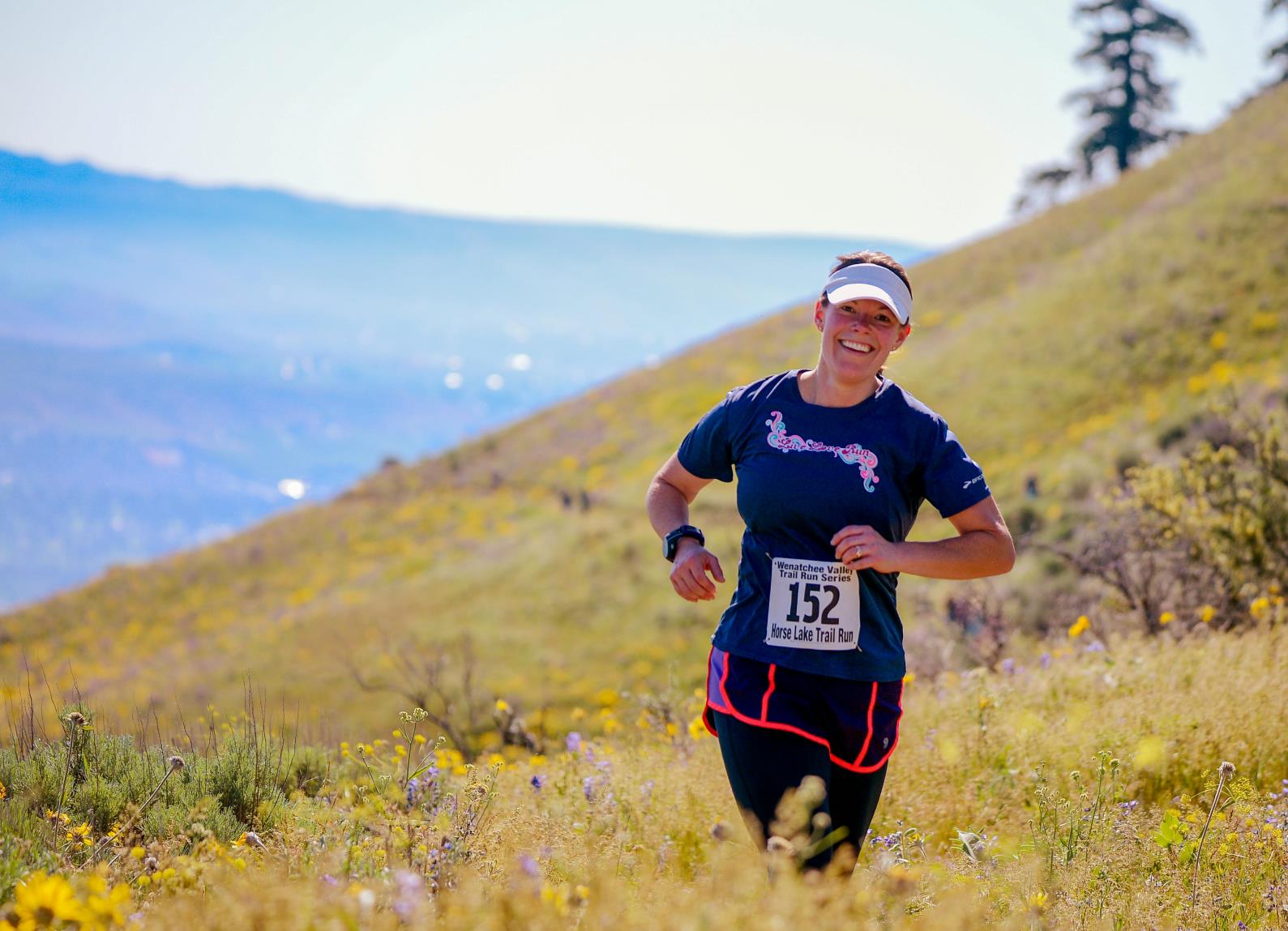
Photo by RUN 4 FFWPU
Get your FREE guide to Running Technique
Switching off on the downhill may cause you to start to heel strike, which is always bad, like slamming on the brakes with every stride. But when running downhill this heel strike will be amplified and will cause added force of gravity on your muscles and joints when you land and can cause muscle damage as the eccentric contractions, or elongating of your muscle fibres, stretch under tension to help your body stay in control with each step you take going down. The most natural way to go downhill once gravity takes over is to lean back and strike on your heels to brake your body and prevent a fall. Each time you land on your heel, you send a jolt of force and tension through your back, quads, and your hips. By the time you reach the bottom of the hill, you’d think you just got the recovery you needed after a steep incline, but instead, you stressed your legs and could be feeling even more fatigued. I have been doing this and not even thinking about it until my knees started to hurt on the downhill and feel even worse in the morning.
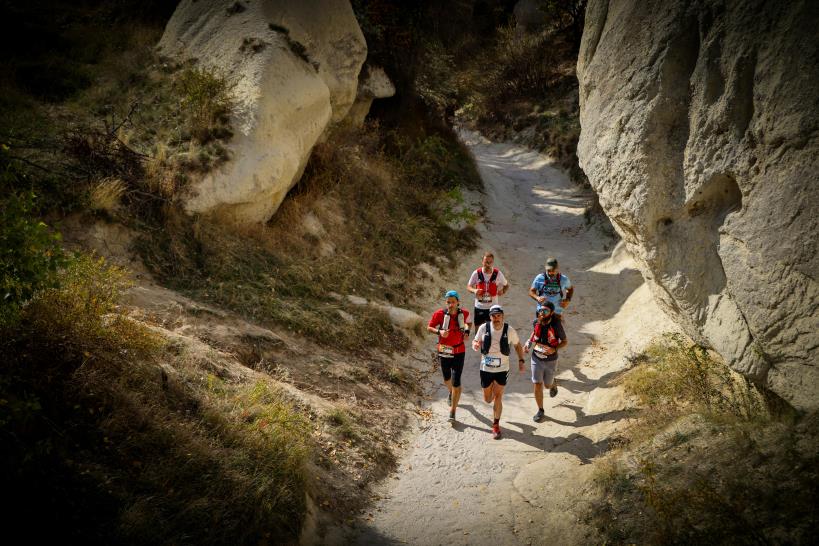
Download your FREE 8-Week Trail Running Training Plan.
Get your FREE guide to Running Technique
So, after a few weeks of technique tweaks I have found the following works for me:
1. Perfecting the Forefoot Strike
Rather than striking your heels on the ground, focus on landing on your forefoot, to strike the ground at your centre of gravity. Never step in front of your body so that you’re leaning forward. Your body should be centred over your knees. This may find a bit strange, especially on steep downhills but with a little practice you will trust in your technique. What I found was that I needed to use a pair of trainers that fitted very well as there was some extra impact on my toes.
2. Take Shorter Strides
You should take lots of small, quick steps to get down the hill. A quicker rhythm helps you land softly and spring off the ground more easily (if you hear your feet pounding the pavement you’re doing it wrong). Your cadence and running form will improve and you’ll be getting your body used to taking more strides per minute which helps you become faster over time.
3. Practice on a Soft Surface
Before you start to use this new technique, consider trying out your new running technique on more forgiving terrain. Since your body absorbs a big impact with each foot strike, start off on a softer terrain, like grass as you work on your downhill technique.
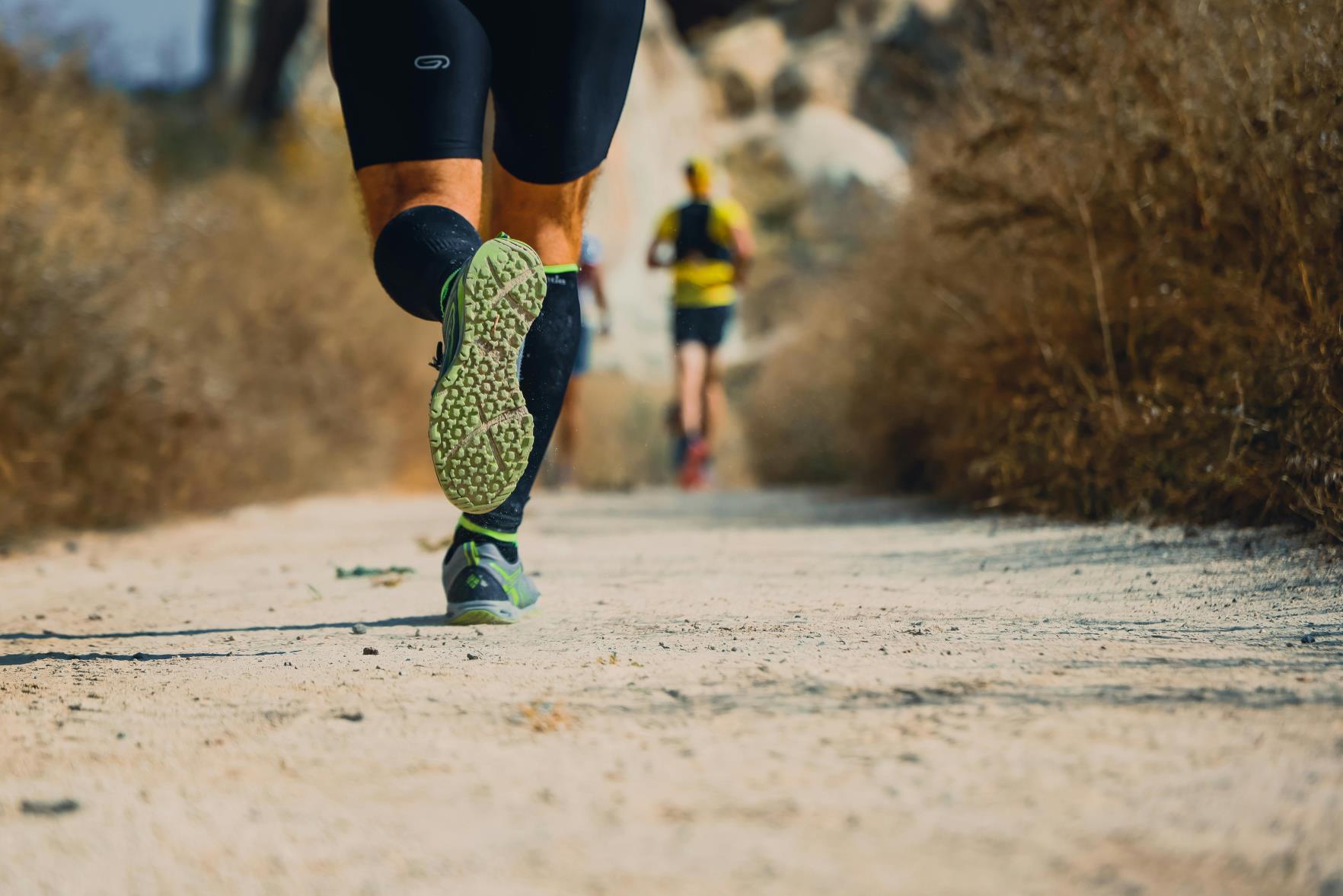
Photo by Emrah Yazıcıoğlu
Download your FREE 8-Week Trail Running Training Plan.
How to tackle the Uphill Sections
For every downhill there is an uphill so we do need to cover how to tackle the uphill sections of your trail run. Talk to any trail runner, and they will tell you "pace goes out the window the second you hit dirt and vert".
Walking during a run can feel a bit wrong but don't stop your watch but embrace the "power hiking". You are still moving it's just that the hill or mountain is steep. It's widely recognised that on any hill steeper than 15.8 degrees it's more efficient to power hike than trying to run (i.e. reduce your energy expenditure). But everyone is different so you can gauge this yourself by how hard it feels to run versus walk a stretch of your race that is hilly.
As with all modes of running the more you do the better your get.
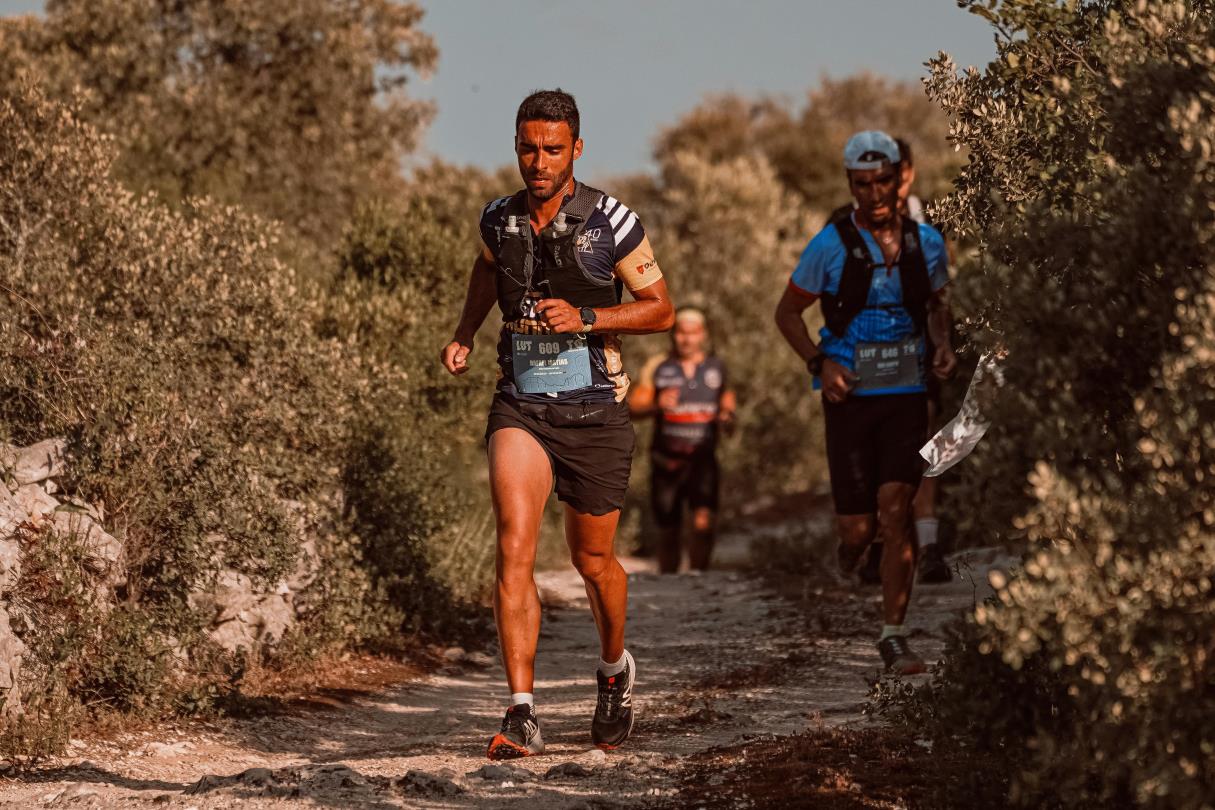
Strength and Conditioning for Runners
Your downhill running prep isn’t just limited to the great outdoors and you can add in some specific strength and conditioning exercises in to your home or gym routine. The focus of these exercises will be on the quads, glutes and ankles.
Step-Downs
This exercise develops powerful quads for stronger hill climbing. It will also help with ankle stability.
Start first with a low height (no more than a six-inch step or the bottom step of your stairs at home). Stand on top of the step. Using one leg at a time, step down to the floor with one foot, tap the floor with your heel, then return back to the starting position on top of the step.
Continue doing this for 10 reps, then alternate the starting leg, and repeat for three rounds total. These mimics the action of your stride moving downhill with your front leg lowering first, and stabilizing the knee and hip of the back leg.
Get your FREE 23-Page Athletes Guide to Strength and Conditioning
Squats
This exercise works the glutes, hamstrings, and quads (quads are the primary muscles used for running uphill).
While holding dumbbells and keeping your feet shoulder width apart, shift your weight to your heels as you lower into a seated position. Keep your eyes forward and descend until your hamstrings are parallel to the ground before you stand back up.
Do 10-12 reps at a controlled pace, three times through.
Get your FREE guide to Running Technique
Deadlift
This exercise works the glutes, hamstrings, and calves, which give you stability and control on downhills.
Stand with feet shoulder width apart. Bend at the waist and knees and pick up a pair of dumbbells from the floor. As you stand up, pinch your shoulder blades together. Then lower back down, tapping the dumbbells on the ground before standing back up.
Do 10-12 reps at a controlled pace, three times through.
Get your FREE 23-Page Athletes Guide to Strength and Conditioning
Forward Lunge
This exercise builds stability and strength that helps you maintain good running form while going up and down.
Start with your feet pointing straight ahead and holding dumbbells. Step forward with your left foot, then bend the left knee until the hamstring is parallel to the floor. Your right knee should touch or come just above the ground. To avoid injury, make sure the left knee stays behind the toes. Step back up and repeat on the other side. Complete 20 total reps, alternating legs.
An alternative if the forward lunge is challenging for you is to do a reverse lunge which puts less pressure on your knees. So instead of stepping forward you step one leg backwards and lower your need as close to the floor as you can.
Download your FREE 8-Week Trail Running Training Plan.
Get your FREE guide to Running Technique
Single Leg Calf Raises
This exercise will help strengthen your ankles and calf muscles.
Balance on one leg while doing a calf raise. If it is too difficult to do on just one leg, then start out using both feet until your balance increases. Stand close to a wall or railing for support.
Start with 6 repetitions and increase from there to 15 reps on each leg three time through.
Get your FREE 23-Page Athletes Guide to Strength and Conditioning
Toe Walks
This exercise also works on ankle strength and stability and has the added benefit of being able to be done anywhere.
Come up and balance on your toes as high as you can and walk forward and backward for a set amount of time in each direction. Start with 30 seconds in each direction and increase time from there.
Download your FREE 8-Week Trail Running Training Plan.
Benefits of Hill Running
The best runners in the world run hills all the time, both in their daily training and in specific hill workouts. They run hill because they know it will benefit their running come race day. The benefits include:
1. Hills can improve your running form by increasing knee lift, joint mobility, and neuromuscular fitness (how well your nervous system communicates with your muscles).
2. Hills improve muscular strength (your legs’ ability to produce force) and power (the ability to produce a lot of force quickly).
3. Hills provide an added cardiovascular boost.
4. Learning how to run downhill efficiently can:
- Improve your foot speed;
- Increase your range of motion;
- Make you a smoother, more efficient runner on any terrain;
- Reduce your risk of injuries as you become adept at not crashing into the ground.
A 2006 study published in the Journal of Strength and Conditioning Research discovered that sprinters who trained on uphill’s and downhills improved their speed and foot turnover more than workouts that only included uphill’s or flat surfaces.

Photo by Krivec Ales
Get your FREE guide to Running Technique
Conclusion: Why you should Run Hills
By strategically incorporating both downhill running and strength training into your training plan, you will not only enhance your ability to handle the challenges of varied terrain with greater ease, but also build the resilience necessary to avoid injuries in the future.
Strengthening key muscle groups improves your stability, reduces the risk of overuse injuries, and optimizes your efficiency when tackling hills, whether you're going up or down.
This combined approach can significantly elevate your overall performance, allowing you to power through tough sections of your race with confidence and endurance. Ultimately, mastering these elements of your training could be the difference between a solid finish and a breakthrough performance, making all the effort well worth it when race day arrives.
Karen Parnell is a Level 3 British Triathlon and IRONMAN Certified Coach, 8020 Endurance Certified Coach, WOWSA Level 3 open water swimming coach and NASM Personal Trainer and Sports Technology Writer.
Karen has recently completed a postgraduate MSc in Sports Performance Coaching at the University of Stirling.
Need a training plan? I have plans on TrainingPeaks and FinalSurge:
I also coach a very small number of athletes one to one for all triathlon and multi-sport distances, open water swimming events and running races, email me for details and availability. Karen.parnell@chilitri.com
Download your FREE 8-Week Trail Running Training Plan.
Get your FREE guide to Running Technique
Get your FREE 23-Page Athletes Guide to Strength and Conditioning
Running training plans on FinalSurge
Running training plans on TrainingPeaks
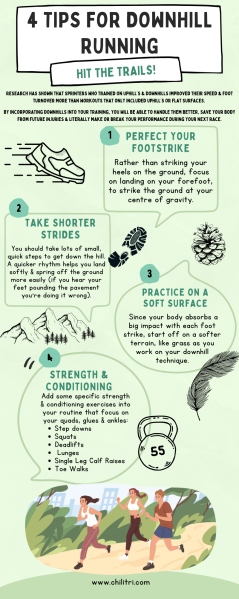
Would you like a high definition of this infographic? Get in touch. karen,parnell@chilitri.com
Download your FREE 8-Week Trail Running Training Plan.
FAQ: Hill Running
What is the technique for running down hills and mountains?
The technique for running down hills and mountains involves adjusting your running form and stride to maintain control, minimize impact, and maximize efficiency. Here are some key elements of the technique:
- Maintain an upright posture: Keep your torso upright and avoid leaning back or bending at the waist. Engage your core muscles to provide stability and balance.
- Shorten your stride: Take shorter and quicker steps compared to running on flat terrain. This allows for better control and reduces the risk of tripping or falling.
- Lean slightly forward: Lean your entire body slightly forward from the ankles, maintaining a controlled forward momentum. This helps you maintain balance and avoid braking too much.
- Use your arms for balance: Swing your arms slightly wider and more actively to help maintain balance and counterbalance your lower body movements.
- Land midfoot or forefoot: Aim to land on the midfoot or forefoot instead of the heel. This promotes a more efficient stride and reduces the impact on your joints.
- Increase cadence: Increase your cadence (stride turnover) to match the steeper descent. This quicker turnover helps maintain control and reduces the load on your legs.
- Be aware of the terrain: Stay alert and constantly assess the terrain ahead. Look for obstacles, loose rocks, or uneven surfaces and adjust your stride and foot placement accordingly.
What are the benefits of using proper technique when running downhill?
Using proper technique when running downhill offers several benefits, including:
- Improved control: Proper technique allows you to maintain better control and stability while navigating the descent.
- Reduced impact: By adjusting your stride and landing midfoot or forefoot, you can reduce the impact on your joints and minimize the risk of injuries such as shin splints or knee pain.
- Increased efficiency: Running downhill with proper technique helps you maintain a smooth and efficient stride, allowing you to cover more ground with less effort.
- Quicker descent times: With improved control and efficiency, you can descend more confidently and potentially achieve faster overall race or trail times.
How can I practice and improve my downhill running technique?
Here are a few tips to practice and improve your downhill running technique:
- Find suitable terrain: Look for trails or routes with gentle downhill slopes to practice the technique before attempting steeper descents.
- Start slow: Begin with a comfortable pace and gradually increase your speed as you become more confident and comfortable with the technique.
- Focus on form: Pay attention to your posture, stride, and foot placement while running downhill. Continually practice and reinforce good form.
- Incorporate downhill-specific workouts: Include specific downhill running workouts in your training, such as downhill repeats or sustained downhill runs, to build strength and enhance technique.
- Seek guidance: If you're new to downhill running or want to refine your technique, consider consulting with a running coach or joining a trail running group for guidance and tips.
Are there any safety considerations for running downhill?
Yes, safety is crucial when running downhill. Consider the following safety considerations:
- Use caution and assess the terrain: Be mindful of the trail or path conditions, including loose rocks, slippery surfaces, or obstacles. Adjust your speed and stride accordingly.
- Wear appropriate footwear: Choose trail running shoes with good traction and ankle support to provide stability and grip on uneven terrain.
- Gradual progression: If you're new to downhill running, start with gradual slopes and gradually increase the difficulty and steepness of the descents as you build confidence and strength.
- Maintain situational awareness: Stay alert, keep an eye on the trail ahead, and be prepared to adjust your stride or direction to navigate any obstacles or changes in terrain.
Remember, practicing and mastering the technique for running downhill can enhance your trail running performance, improve your confidence on descents, and reduce the risk of injuries. Start with gradual progressions, be mindful of safety, and enjoy the exhilaration of running downhill with control and efficiency.
Why is hill running beneficial for runners?
Hill running offers several benefits for runners, including:
- Increased strength: Running uphill engages the muscles in your lower body, particularly the calves, quads, hamstrings, and glutes, helping to build strength and power.
- Improved cardiovascular fitness: Running uphill challenges your cardiovascular system, increasing your heart rate and lung capacity, and improving overall endurance.
- Enhanced running form: Hill running encourages proper running mechanics, including shorter strides, higher knee lift, and better arm drive, which can translate to improved form on flat terrain.
- Mental resilience: Conquering hills builds mental toughness, perseverance, and the ability to push through challenging situations during races or training.
How should I approach hill running as a beginner?
If you're new to hill running, it's important to start gradually and progress at a pace that suits your fitness level. Here are some tips:
- Find gentle inclines: Begin with small, gradual hills before tackling steeper slopes. This allows your body to adapt to the demands of hill running.
- Focus on effort, not speed: Instead of aiming for a specific pace, focus on maintaining a consistent effort level while running uphill.
- Use a shorter stride: When running uphill, take shorter strides to maintain your cadence and prevent over striding, which can lead to inefficiency and fatigue.
- Engage your arms: Swing your arms more actively to generate momentum and help propel you uphill.
- Recover on the downhill: Use the downhill portions of your run to recover and catch your breath, allowing your muscles to relax and prepare for the next ascent.
How can I improve my hill running technique?
To improve your hill running technique, consider the following tips:
- Maintain an upright posture: Keep your torso upright, engage your core, and avoid slouching or leaning too far forward or backward.
- Look ahead: Focus your gaze on the road or trail ahead rather than looking down at your feet. This helps you maintain balance and anticipate the terrain.
- Use your arms: Swing your arms more vigorously, keeping them bent at a 90-degree angle. Your arm drive can provide additional power and help you maintain momentum.
- Run with a midfoot strike: Aim to land on the midfoot rather than the heel when running uphill. This promotes a more efficient stride and reduces the risk of strain on your lower legs.
- Practice hill repeats: Incorporate hill repeats into your training by running up a hill at a challenging but sustainable effort level, then recovering on the way down. Repeat this process multiple times to build strength and stamina.
How often should I incorporate hill running into my training?
The frequency of hill running sessions depends on your goals, fitness level, and overall training plan. As a general guideline, aim to incorporate one or two hill running sessions per week. Gradually increase the intensity and duration of your hill workouts over time to continually challenge yourself.
Are there any safety considerations for hill running?
Yes, safety is important when hill running. Here are some safety considerations:
- Choose the right hills: Start with hills that are safe and appropriate for your fitness level. Avoid excessively steep or technical terrain until you've gained experience and confidence.
- Warm up properly: Prioritize a thorough warm-up to prepare your muscles and joints for the increased demands of hill running.
- Use caution on descents: Maintain control and reduce your speed when running downhill to minimize the risk of falls or injuries.
- Wear appropriate footwear: Use trail running shoes with good traction for grip and stability on uneven surfaces.
- Listen to your body: If you experience pain, discomfort, or excessive fatigue, listen to your body, and take appropriate rest and recovery days.
Remember, hill running can be an excellent addition to your training routine, providing physical and mental benefits. Start gradually, focus on proper technique, and enjoy the challenge and rewards of conquering hills.
References
Downhill Running: What Are The Effects and How Can We Adapt? A Narrative Review - PMC (nih.gov)
(PDF) Model of Performance in Downhill Trail Running: A Multifactorial Approach (researchgate.net)
#chilitri #running #trailrunning #runningtips #runningdownhill #triathlon #triathloncoach #powerhiking #hiking #swimmingtrainingplan #cyclingtrainingplan #runningtrainingplan #swimming #cycling #running
